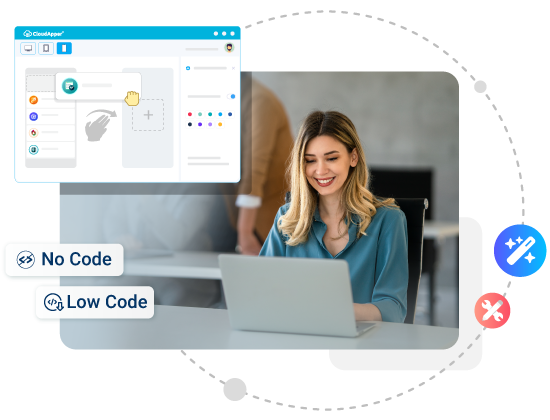According to several new product category ecosystem maps emerging in the venture capital industry, there is obviously a micro-bubble forming around no-code technologies, a software environment in which non-programmers may drag and drop programs. The increasing number of inbound sales calls connected to no-code providers indicates that it is past time to address the business user community’s potential and difficulties. Though manufacturers would have you believe that no-code solutions are a simple and quick cure for application development and workflow management difficulties, some obstacles remain that must be carefully considered before utilizing this new and creative technology.
There are several complicated technological challenges that must be resolved before no-code platforms may become the new standard. There is still a learning curve associated with these technologies, which IT directors and CIOs should evaluate prior to using them. This will necessitate some “unlearning” before we can completely profit from these applications. Though the possibility is enormous and may help shape current development, IT decision-makers should continue to study and handle this developing technology like they would any other—by properly analyzing the benefits and drawbacks before diving into instant deployment.
Emphasizing the Possibility
Even with present problems, it’s critical to recognize the enormous benefits that employees will enjoy if technology is applied properly:
Cost Savings: Users of no-code apps will be able to avoid incurring further technological debt (also known as design debt or code debt). By developing their own applications on a consolidated app platform, business users may avoid the additional rework that nearly always occurs when a more complex approach to software development is used.
No-code innovation has the potential to accelerate innovation by allowing users to make disruptive bets rapidly by testing apps in the market and obtaining instant feedback.
Optimal User Experience: Certain no-code apps provide a superior user experience to a large number of currently accessible deliverables. There is an element of interaction and feedback in no-code apps. It enables more strategic and free-flowing dialogues throughout the organization.
Consider the following use case example: A group of business practitioners can automate a traditional business process that relies on a lengthy checklist to track the workflow associated with a normal audit engagement. The conventional method entails a complicated spider web of manual operations, Excel data processing, and PowerPoint reporting. CloudApper, a no-code platform, can replace all of this with a single process app. A typical information technology project that may have taken months and required a significant financial expenditure only a few years ago can now be completed in weeks for a fraction of the cost.
Getting Ready for Obstacles
While there are issues associated with no-code technologies, they are manageable. However, as is typically the case, before rushing in and redesigning current systems, CIOs and other executives should examine the following:
Platform Preference: Within the internal developer community, there is some resistance to change management. Developers who have spent many hours on React/Angular/Full Stack programming regard the no-code movement as a fad and a toy. Many of them are unwilling to embrace these new apps as a true substitute for Full Stack development. Apart from overcoming human aversion to change, “unlearning” one tool in order to learn another takes considerably longer. This can create complications for an in-flight project.
Adaptability: Another issue that arises is that by introducing no-code technologies, technology leaders are effectively establishing a new category of practitioners who are neither developers nor pure business team members. There are other elements to consider with this, including how this group of practitioners fits within the delivery life cycle. Will they be treated seriously for what may be considered “throwaway” work? Additionally, we must accept that no-code technology platforms still have a learning curve that will take time for these new practitioners to surmount.
Selection: Additionally, it is critical to examine the complicated ecosystem of competing providers while selecting a vendor. Which no-code platform does an organization invest in and train on when the clear leader is unknown? There is a risk of acting prematurely and training only on a proprietary platform. There are currently no apparent winners in the mainstream, open-source, no-code platform space. Acquiring and certifying a new platform for fine-grained access control/security, particularly for production applications, is costly and time-consuming. Along with these expenses, many of these burgeoning platforms are not inexpensive.
Aiming Forward
While there are legitimate concerns to consider about no-code platform, many of them may be handled with due diligence. Before leaping into enterprise-wide adoption, all stakeholders must assess which suppliers emerge as platform leaders, examine how others incorporate new practitioners, and communicate honestly with teams about the developing platforms’ value proposition and associated costs.
No-code platforms may very well be the game-changing solutions that many believe they are—but like with any emerging technology, CIOs and IT directors should exercise caution when deciding what to adopt across their organizations.
What is CloudApper AI Platform?
CloudApper AI is an advanced platform that enables organizations to integrate AI into their existing enterprise systems effortlessly, without the need for technical expertise, costly development, or upgrading the underlying infrastructure. By transforming legacy systems into AI-capable solutions, CloudApper allows companies to harness the power of Generative AI quickly and efficiently. This approach has been successfully implemented with leading systems like UKG, Workday, Oracle, Paradox, Amazon AWS Bedrock and can be applied across various industries, helping businesses enhance productivity, automate processes, and gain deeper insights without the usual complexities. With CloudApper AI, you can start experiencing the transformative benefits of AI today. Learn More

















